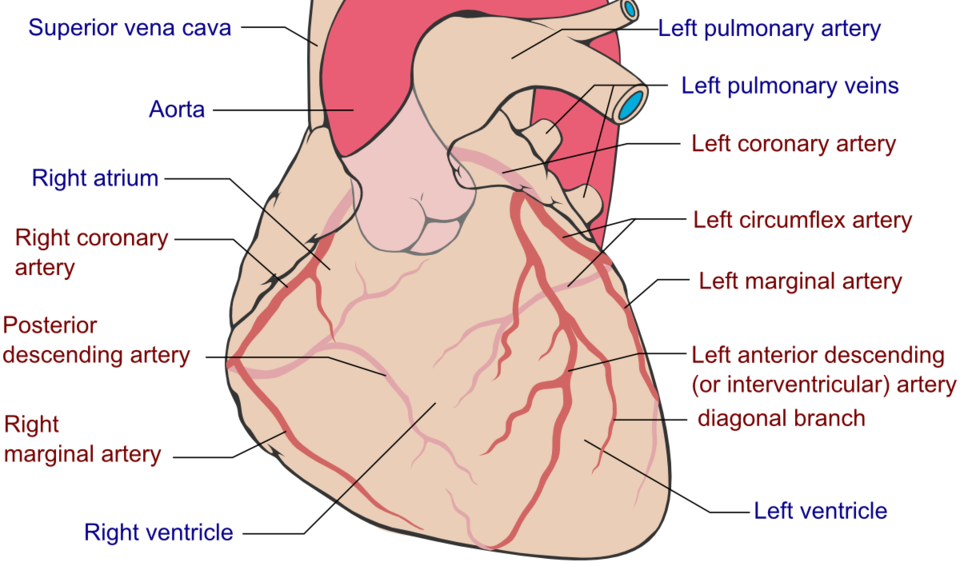Cardiology > Pulmonary Arterial Hypertension (PAH)
Pulmonary Arterial Hypertension (PAH)
Empty
1. Knuuti J, Wijns W, Saraste A, Capodanno D, Barbato E, Funck-Brentano C, et al. 2019 ESC Guidelines for the diagnosis and management of chronic coronary syndromes. Eur Heart J. 2020;41(3):407-477.
PMID: 31504439
DOI: https://doi.org/10.1093/eurheartj/ehz425
2. Fihn SD, Gardin JM, Abrams J, Berra K, Blankenship JC, Dallas AP, et al. 2012 ACCF/AHA/ACP/AATS/PCNA/SCAI/STS guideline for the diagnosis and management of patients with stable ischemic heart disease. J Am Coll Cardiol. 2012;60(24):e44-e164.
PMID: 23182125
DOI: https://doi.org/10.1016/j.jacc.2012.07.013
3. Khan MA, Hashim MJ, Mustafa H, Baniyas MY, Al Suwaidi SKBM, AlKatheeri R, et al. Global epidemiology of ischemic heart disease: Results from the Global Burden of Disease Study. Cureus. 2020;12(7):e9349.
PMID: 32742886
DOI: 10.7759/cureus.9349
4. Ibanez B, James S, Agewall S, Antunes MJ, Bucciarelli-Ducci C, Bueno H, et al. 2017 ESC Guidelines for the management of acute myocardial infarction in patients presenting with ST-segment elevation. Eur Heart J. 2018;39(2):119-177.
PMID: 28886621
DOI: https://doi.org/10.1093/eurheartj/ehx393
5. Amsterdam EA, Wenger NK, Brindis RG, Casey DE Jr, Ganiats TG, Holmes DR Jr, et al. 2014 AHA/ACC guideline for the management of patients with non–ST-elevation acute coronary syndromes. J Am Coll Cardiol. 2014;64(24):e139-e228.
PMID: 25260716
DOI: https://doi.org/10.1016/j.jacc.2014.09.017
Background
Pulmonary arterial hypertension (PAH) is a chronic, progressive disorder characterized by elevated pulmonary arterial pressure (mean PAP ≥25 mmHg at rest by right heart catheterization) with a normal pulmonary capillary wedge pressure (≤15 mmHg), indicating pre-capillary pulmonary hypertension. It results from vascular remodeling of the small pulmonary arteries, leading to increased pulmonary vascular resistance (PVR), right ventricular overload, and eventual right heart failure.
Classification/Types
I) WHO Group 1 PAH
Idiopathic PAH (IPAH)
Heritable PAH (BMPR2 mutation, etc.)
Drug- and toxin-induced (e.g., methamphetamine, fenfluramine)
Associated with:
Connective tissue diseases (especially systemic sclerosis)
HIV infection
Portal hypertension
Congenital heart disease
Schistosomiasis
II) Subtypes (Pathologic/Functional)
Vasoreactive PAH (responsive to calcium channel blockers)
Non-vasoreactive PAH (requires targeted therapy)
- Pathophysiology
- PAH involves endothelial dysfunction, smooth muscle proliferation, thrombosis in situ, and remodeling of small pulmonary arterioles. The imbalance between vasodilators (e.g., nitric oxide, prostacyclin) and vasoconstrictors (e.g., endothelin-1) results in progressive vasoconstriction and vascular remodeling. This leads to increased pulmonary artery pressures, elevated PVR, and right ventricular hypertrophy and failure.
Epidemiology
Prevalence: ~15–50 cases/million in developed countries
Age: Commonly diagnosed between 30–60 years
Sex: More frequent in females (2:1 ratio)
Associated with high mortality if untreated
Etiology
- I) Idiopathic or Heritable Causes
- BMPR2, ALK1, ENG mutations
- Sporadic (no family history)
- II) Associated Conditions
- Connective tissue diseases (especially systemic sclerosis)
- Congenital systemic-to-pulmonary shunts
- HIV infection
- Portal hypertension
- Chronic hemolytic anemia
- Drug/toxin exposure (e.g., anorexigens, methamphetamines)
Clinical Presentation
I) History (Symptoms)
Progressive exertional dyspnea
Fatigue and weakness
Non-productive cough
Chest pain or tightness (especially on exertion)
Syncope or near-syncope (suggests advanced disease)
Palpitations
Peripheral edema (late sign due to RV failure)
II) Physical Exam (Signs)
General Appearance
Chronically ill appearance
Signs of effort intolerance
Cyanosis in advanced stages
Vital Signs
Resting tachycardia
Low-normal or decreased blood pressure
Orthostatic hypotension may occur
Hypoxemia on exertion or at rest
Respiratory System
Clear lung fields early (unless concomitant lung disease)
Late crackles may suggest superimposed interstitial disease
Tachypnea
Cardiovascular System
Loud, palpable P2 component of S2 (due to elevated pulmonary pressure)
Right ventricular heave (from RV hypertrophy)
Right-sided S3 or S4
Tricuspid regurgitation murmur
Jugular venous distension
Hepatojugular reflux
Peripheral edema, ascites in right heart failure
Neurological System
Syncope or presyncope (especially on exertion)
Confusion in severe hypoxemia or right heart failure
Skin/Extremities
Digital clubbing (less common in isolated PAH, more common if associated with lung disease)
Cyanosis (central or peripheral)
Cool extremities in low-output states
Ocular
No primary ocular findings, but hypoxia may manifest as papilledema in extreme cases
Differential Diagnosis (DDx)
Left heart disease (e.g., heart failure with preserved or reduced EF)
Chronic thromboembolic pulmonary hypertension (CTEPH)
Lung diseases/hypoxia (e.g., COPD, ILD)
Pulmonary veno-occlusive disease
Congenital heart disease with Eisenmenger syndrome
Pericardial disease
Anemia-related high-output states
Diagnostic Tests
I) Initial Evaluation
Chest X-ray: Enlarged pulmonary arteries, right heart enlargement
ECG: Right axis deviation, RV hypertrophy, right atrial enlargement
CBC/CMP: Rule out anemia, assess liver/kidney function
BNP or NT-proBNP: Marker of right ventricular strain
ANA, HIV, LFTs: Identify associated conditions
TTE (Transthoracic Echo): Elevated pulmonary artery systolic pressure (PASP), RV size and function, tricuspid regurgitation velocity
6-Minute Walk Test (6MWT): Functional status and desaturation monitoring
II) Confirmatory Testing
Right Heart Catheterization (Gold Standard):
Mean PAP ≥25 mmHg at rest
Pulmonary capillary wedge pressure (PCWP) ≤15 mmHg
Elevated PVR (>3 Wood units)
Vasoreactivity Testing (in RHC): Inhaled nitric oxide, epoprostenol, or adenosine used to assess responsiveness
Pulmonary Function Tests (PFTs): May show isolated ↓DLCO
V/Q Scan: To exclude chronic thromboembolic disease (CTEPH)
HRCT: Evaluate for associated parenchymal lung disease
MRI of heart (if available): Detailed RV assessment
Treatment
I) General Principles
Early diagnosis and management improve outcomes
Identify and treat underlying conditions
Treatment stratified by WHO functional class and risk status
II) Pharmacologic Therapy
Vasodilator Therapy (Targeted)
Endothelin receptor antagonists: Bosentan, Ambrisentan
Phosphodiesterase-5 inhibitors: Sildenafil, Tadalafil
Prostacyclin analogs: Epoprostenol (IV), Treprostinil (SC/inhaled), Iloprost
Soluble guanylate cyclase stimulators: Riociguat
Vasoreactive Patients
High-dose calcium channel blockers (e.g., nifedipine, diltiazem) – Only if positive vasoreactivity test
Anticoagulation
Consider in idiopathic PAH (controversial)
Required in CTEPH (Group 4, not PAH)
Diuretics
For symptom control of right heart failure (edema, ascites)
Oxygen Therapy
If resting hypoxemia (SpO₂ <88%)
III) Supportive Measures
- Pulmonary rehabilitation
- Sodium/fluid restriction in RV failure
- Avoid pregnancy (high maternal/fetal mortality in PAH)
- Psychosocial support
Patient Education, Screening, and Prevention
Educate about disease progression and medication adherence
Avoid high altitudes, strenuous exertion, and volume overload
Immunizations: Influenza, pneumococcal, COVID-19
Genetic counseling in heritable PAH
Routine screening for PAH in systemic sclerosis (e.g., annual echocardiography)
Consults/Referrals
- Pulmonology and cardiology (specialized PAH centers preferred)
- Rheumatology (if connective tissue disease suspected)
- Obstetrics (for counseling on contraception or pregnancy risks)
- Palliative care in advanced stages
- Transplant team if severe or refractory to therapy
Follow-Up
Short-Term
Monitor functional class, symptoms, 6MWT
Serial BNP/NT-proBNP levels
TTE every 6–12 months
Long-Term
Periodic RHC if worsening or unclear clinical picture
Evaluate for lung transplantation in advanced or refractory cases
Monitor for drug-related side effects (e.g., liver function for endothelin receptor antagonists)
Prognosis
- Prognosis depends on etiology, functional class, and response to therapy
- Poor prognosis in:
- Systemic sclerosis-associated PAH
- Syncope, severe RV dysfunction
- Elevated BNP, rapid disease progression
- Median survival in untreated idiopathic PAH: ~2.8 years
- Targeted therapies and lung transplantation have significantly improved outcomes
Recommended
- Valvular Heart Disease
- Aortic Regurgitation
- Mitral Regurgitation
- Mitral Stenosis
- Mitral Valve Prolapse
- Pulmonic Stenosis (Pulmonary Stenosis)
- Pulmonic Valvular Stenosis
- Pulmonary Arterial Hypertension
- Idiopathic Pulmonary Arterial Hypertension
- Idiopathic Pulmonary Arterial Hypertension
- Tricuspid Atresia
- Tricuspid Regurgitation
- Prosthetic Heart Valves (including complications)
- Functional Murmurs

Stay on top of medicine. Get connected. Crush the boards.
HMD is a beacon of medical education, committed to forging a global network of physicians, medical students, and allied healthcare professionals.
